|

Membership: George J. Haas, William R. Saunders, Lee Bogart, &
George Dutton
Launched: 10/16/ 2000 Updated:
1/17/2006
from
CydoniaInstitute Website
Contents
THE 2001 FACE
ON MARS
On May 24, 2001, without any fan fair or public notice, NASA
released a long awaited high resolution, "full faced" view of the
Face on Mars (figure 1). It appeared to the world that NASA had
finally hit it’s mark and "scotched this thing for good". Once again
the "Face" was declared "a pile of rocks" and maintained no
resemblance to a human face! The New York Times was reported to say:
"NASA released a new image [of the
"Face on Mars"] that shows the area in far sharper detail, but
reduces any resemblance to a human face."
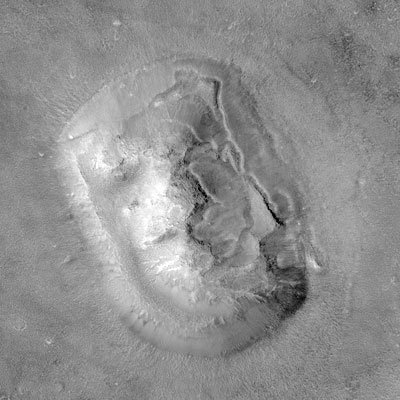
Figure 1
The 2001 Face
A second "full faced" image of the "Face" NASA/JPL MOC E03-00824.
Note: the distinct "Feline" features on the right side.
The truth was, the new image wasn’t new!
It was almost two months old. The actual image, which was taken
earlier in the year on April 8th, was held back form the public for
almost two months (sitting "in the can" as they say, somewhere at
NASA/JPL).
This down time, conveniently provided NASA with a
sufficient time frame to prepare a carefully orchestrated strategy
of ground zero "damage control". So, subsequently, a highly negative
propaganda campaign was simultaneously released, on the coat tails
of the new image, and posted on several official NASA web sites.
This media blitz was designed to stop the "Face"
dead in it’s
tracks. Although NASA was actually forced into taking the picture in
the first place, by the attorneys for FACETS and finally forced to
release the photo by the current administration, there was no way
NASA was going to let this Lion lay! NASA and company were "hell
bent" on discrediting any scientific analysis of this image and God
forbid that someone in the media had noticed the "cat-like"
appearance of the eastern side of this "pile of rocks" before they
could divert their attention elsewhere.
Oh yes, an all out "War" was
on and the real debate was just getting started...again.
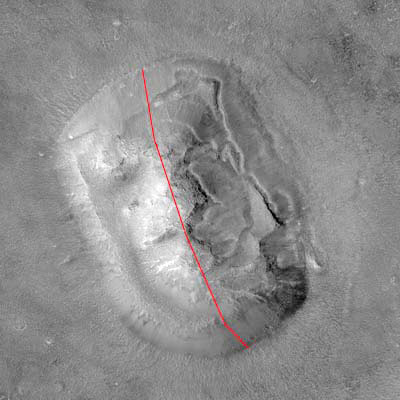
Figure 2
The Line of Demarcation
Note the line (in red) that separates the two halves of the "Face"
appears irregular, and arched,
this is caused by the
curvature of this bifurcated structure along the "facial split" and
the camera angle (from the east) "
As soon the new image hit the web many
attempts to mirror the two sides of the new 2001 "Face" image were
being presented, either too wide or too narrow. Many advocates of
the "Face", who had mirrored of the "feline" side, totally disregard
any sense of a central axis by including portions of the "W" shaped
emblem from the "humanoid" side.
It has been our experience that all
of these bifurcated "geoglyphs" (and there are more) have
demarcation lines which are signaled by precisely placed "markers"
(figure 2). Two "markers" for this demarcation line runs along the
edge of the "half" emblem of the triad leaf symbol ("W") that we
identified at the center of the forehead on the "humanoid" side.
A second "marker" is at the edge of the
central "tooth" feature on the "humanoid" side and the protruding
"tongue" and "fang" on the "feline side (see figure 4). There is
also a small vertical bar located at the edge of the mane area,
placed between the "feline" and "humanoid" faces. You will notice
this "marker", in many of the incorrectly mirrored splits of the
feline side of the "Face", which appears as two vertical parallel
lines. This "vertical bar" is the central axis (or marker) between
the two faces.
It should be noted that because of the 3 dimensional
aspect of this bifurcated "facial" structure and the curvature of
it’s features, the demarcation line would appear irregular, and
arched across such an anthropomorphiclly designed topography.
Back to Contents
It’s Narrowly
Human
When the new image is mirrored, along this central axis, two
distinct and separate "mask" are revealed. The left side, although
narrow and highly reflective, still maintains a similar "humanoid"
appearance, as seen in the 1998 image (figure.2)
Notice in the 2001
image how narrow the base or platform is, on the west side, that
forms a feature what has been referred to as the "fanned headdress"
on the left side of the "Face". When the last two images of the
"Humanoid" side of the Face are compared, the loss of detail in the
new image becomes obvious. In the new image (E03-00824) it becomes
quite apparent that, because of some type of highly reflective
"metallic" surface, a lot of the detail, on this side of the "Face",
is washed out.
The new image, because of it’s foreshortening, has
prompted many researchers to say it has a very "simian" appearance
while the 1998 image has a more human. Although similar, the
previous portrait leans more towards expressing the features of a Neandertal. Note the deep set eyes, heavy forehead, the jutting
facial structure, the protruding nasal cavity and prominent jaw
line. Again we are reminded of the task of estimating the age of
these structures and how it relates to our existence.
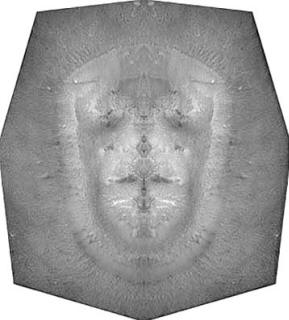 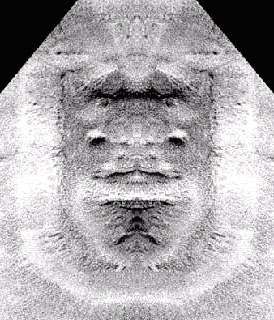
Figure 0.2
Comparison of both "Humanoid" sides of the Face on Mars 1998 & 2001
(the left side: west).
Left: 2001 Humanoid side. (EO3-00824)
Note; the overall highly reflective "metallic" surface and the
distortion of the facial features.
Also notice the narrow sides of the"fanned" lateral element of the
headdress and the triad "W" emblem.
Right: 1998 Humanoid side (SPI-22003)
Note: the detail of facial features. Such as the eyes, nose, and
chin ornaments.
Also notice the wide "fanned" lateral element of the headdress,
which includes a triad "W" emblem.
Besides the over exposure of light to
the west side of the "Face" we are pleased to announce the
continuous presence of the, now famous, triad "W" emblem placed at
the center of the forehead. This Mesoamerican "cultural marker"
(illustration A&B) has been identified as a consistent feature in
all of the last 4 images of the "Face on Mars".
This triad "W"
emblem is actually presented as a "v" shaped sign, which is only
half of the whole emblem . It can even be seen etched across the
forehead area of the "Humanoid" headdress in the original "Cat-Box"
image and is still present in the later release of the (same)
rectified (cat-box) image (SPI-22003).
It is also seen in the
partial "M16 Face" which featured the "eye" and is seen again in the
current 2001 (EO3-00824) image.
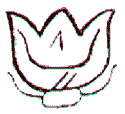
Illustration A
The Cultural Marker Olmec/Maya Tri-leaf "W" glyph.
Symbolic of Royalty (corn).
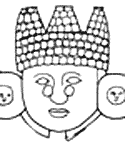
Illustration B
Atlantean Figure (detail) Maya; Temple of the Jaguar.
Note the "W" headdress and the "teardrop" nose ornament.
Back to Contents
The
"Cat-Box"
In 1996 NASA launched the long awaited Mars Global Surveyor (MGS)
spacecraft with Dr. Malin once again at the camera’s helm. We were
told that the MGS would thoroughly map the whole planet, including
Cydonia, with the most detailed images ever taken of the Martian
surface. The Mars Orbiter Camera (MOC) began imaging the Red Planet
in September of 1997. On April 5, 1998 the Mars Orbital Camera (MOC)
aboard the Surveyor was slated to re-image the "Face" and put an end
to the controversy.
On April 6, 1998 Dr. Malin immediately released
a distorted, low contrast image of the face to the international
media (figure 1) and proclaimed that the "face was just a pile of
rocks".
This raw image of the "Face" was distorted and so stretched
out that it was immediately said to look more like a "sandal print
or a stuffed chili pepper" than a face, by the New York Times.

Figure 1
NASA’s press release image of the MGS ’Face’; termed the ’Cat Box’
Note; the elongated oval shape of the crater. This "crater" was
deleted from most press releases.
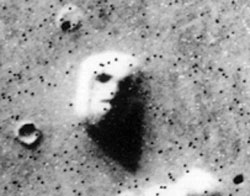
Figure 2
The original Viking "Face".
Note; the round the crater on the left.
Back to Contents
The "Face on
Mars"
A few hours after releasing the distorted, low contrast image known
as the "cat box" to the international media, NASA posted a very
different image of the MGS "Face" (SP1-22003) on their web site.
(figure 1) This image had the distortion corrected and the contrast
enhanced.
In the newly rectified image of the "Face" the most
startling feature besides the distinguishable eyes, nose, and mouth
was the presence of an elaborately styled headdress. When the new
"Face" is split into two halves and mirrored, Hoagland’s anticipated
sphinx-like attributes of the Martian "Face" become startlingly
evident (figure 2).

Figure 1
NASA’s enhanced version of the MGS (cat-box) Face.
Left - NASA’s JPL enhanced image (SP1-22003).
Right - contrast reversal image
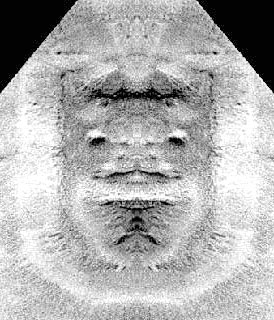
Figure 2a
Humanoid Face
Left side mirrored (contrast reversal).
Note; the eyes, nose, mouth (including two front teeth) and
headdress featuring a "W" shaped emblem.
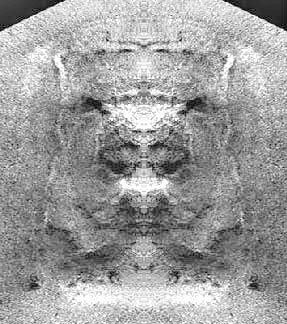
Figure 2b
Feline Face
Right side mirrored (contrast reversal).
Note; the squinting eyes, the muzzle, fangs, mane, and crest on the
forehead.
Back to Contents
The "M16
Face"
And the saga continues. We are now being spoon-fed "bits and pieces"
of the "Face on Mars", by Malin and company. On January 31, 2001
Malin/NASA/JPL released 7 additional Cydonia images that were
subsequently obtained after the last release of images back in April
2000. In this latest "dump" of Cydonia images a fine detail of the
left (Humanoid) side of the "Face" was included for our feverish
consumption; M16-00184 (figure 1).
The new "M16 Face" is the highest
resolution picture ever taken of this controversial structure so
far. It is 1.7 meters, or 5.6 feet per pixel. Unfortunately, Malin/NASA
has presented this new "high-res" detailed image of the "Face" in a
washed out "negative" presentation.
This practice is a common public
relations tactic employed by both NASA and Malin in an effort to
downplay any artificial features that the "Face" (or any other
structure) may exhibit. By releasing gleaming images in extreme
brightness they can obscure the detail. Once a "negative reversal"
(to limit the brightness) is performed on the new "M16 Face", it’s
fine facial features are easily observer (figure 2).
The new image, when carefully examined, is actually very revealing
(figure 3). It not only captures a small portion of the "headdress
", the controversial "teardrop", and a tiny corner of the "mouth"
area but, it nails the "brow" area complete with an "eye" and
"pupil". Every feature that has been previously contemplated has
been reinforced in this new image.
Although disappointing in it’s
lack of totality, this new image confirms the existence of all of
these aforementioned anatomical features including the "eye". Note;
the projecting edge of the "brow", the almond shaped eye socket and
a pronounced circular "eye" feature including an "iris".
Interestingly, the famous "Teardrop" feature, directly below the
"eye", appears to be more steep and rectangular in this new image.
The big surprise here is not the presents of an "iris" but, the
discovery an ornamental "trophy head", mounted along the edge of the
"eye" and "brow". I noticed an odd muzzle feature including a head
formation sprouting out of the "brow" area, right next to the "eye".
This odd "animal" was independently identified as a "deer effigy" by
K.Ksamurai , note; the antlers.
An analytical drawing of these
amazing facial features is provided in figure 4.
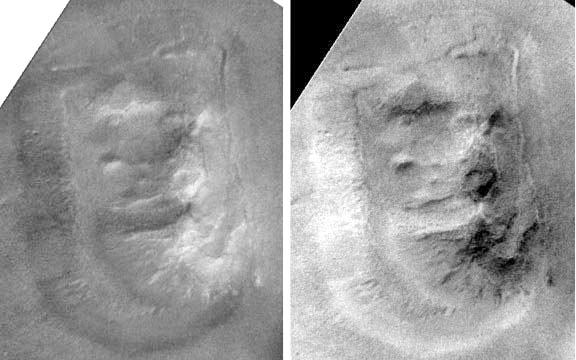
Figure 1
M16 Face (M16 00184)
Note; the high albedo features and lack of detail.
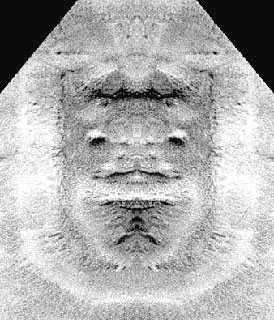
Figure 2
M16 Face (negative reversal)
Note; the projecting edge of the "brow", and the pronounced "eye"
feature.
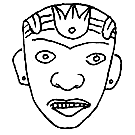
Figure 3
Detail (enlargement) of facial features in the new "M16 Face".
Note; the "deer" ornament in the brow, the almond shaped eye socket
and the "iris" in the eye.

Figure 4
Analytical Drawing of "facial features" in the new "M16 Face".
Note; the "Deer" ornament above the almond shaped "eye" socket.
Back to Contents
The "Face on
Mars" wears an Olmec Headdress
The most prominent feature on the left side of the "Face" is the
elaborate headdress, which has attracted a lot of attention among
concerned researchers. The evidence of a Mars version of a sphinx
and the apparent pyramidal structures in the surrounding area has
some researchers, suggesting that this headdress feature may be
another Egyptian link.
This interpretation is fostered by the
"lateral stripes" or "furrows" that run perpendicular to the gradual
slope of the base, off the left side of the "Face". The combined
effect of the headdress and these faint "stripes" that run to the
ground in an orderly fashion, have been interpreted by researcher
Mike Bara, as resembling an Egyptian death mask, much like the one
worn by King Tutankhamun (figure 3).
The appearance of a second Egyptian motif was also alluded to on the
forehead of the "Face" by Mike Bara on his web site. An outlined
object was detected at the center of the headdress that he and other
researchers thought looked "faintly" like a protruding cobra. When
this object or marking is viewed in the mirrored version of the
"Face", a very geometric "W" shaped mark appears right in the center
of the forehead. In the half image of the humanoid side of the face
this "W" appears in the shape of a "V".
If this "V" shaped object
was intended to portray a profiled cobra, then it would have been
represented as only one half of the Egyptian serpent and not a full
cobra head. So perhaps this headdress did not have a direct Egyptian
connection after all. After conducting a little research into this
"W" shaped emblem with various styles of cultural headdress, a match
was soon discovered. Unexpectedly this Martian insignia was found to
be reminiscent of the three-point leaf configuration that the
ancient Maya displayed on their headdress.
As evident in this
Greenstone mask of the first century B.C., the Maya exhibited a
three-pointed leaf emblem on their headbands to signify the "Crown"
of early kings (figure 1).

Figure 1
Maya greenstone mask of a king, found at Tikal.
Note; the three point crown emblem

Figure 2
Olmec three pointed glyph.
Note; the three point corn emblem.
This basic triad crown emblem was adopted by the Maya from an
earlier "Mother Culture" of Mesoamerica called the Olmec.
The
origins of the glyph was to denote the transformational properties
of corn (figure 2). It was also discovered that the Olmec
incorporated the use of the same lateral striped or grooved feature
on their headdresses, similar to the Egyptians. In a set of Olmec
sculptures, that were recently found in Mexico, a pair of kneeling
twins wearing an Egyptian styled headdress were revealed in Veracruz
(figure 4).
Surprisingly, this lateral striped effect is commonly
known amongst archaeologists as a typical imprint of Olmec royalty.
What ever kind of rudimentary contact the ancient Olmec may have had
with Egypt, it is clear that any attempt to establish an ancient
inter-cultural alliance between these two civilizations is strongly
denied by most scholars, despite the growing evidence (seen here and
on Mars).

Figure 4
Olmec twin sculptures from Veracruz.
Olmec "Arqueologiz Mexicana"
Olmec art by Beatriz De La Fuente.
Note; the lateral
striped headdress.
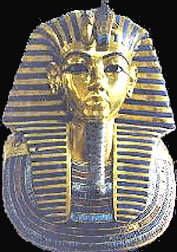
Figure 3
Death Mask of Egyptian King Tutankhamun
Back to Contents
The "Face on
Mars" Has Teeth
Another interesting attribute of Mesoamerican royalty that is
incorporated in the "Martian Sphinx", is the use of elaborate facial
ornaments. Many factions of the ancient Mesoamerican people produced
elaborate facial adornments out of gold, which were sometimes called
the "tears" of the gods. Nose ornaments were shaped in such exotic
designs as that of geometric "Hummingbirds" and "Butterflies"
(figure 1a).
These ceremonial facial ornaments are so large that
they sometimes covered the entire nose.
Richard Hoagland and other
researchers have been concerned about the absence of a distinct nose
formation in the new MOC image. They have speculated that the nose
was blown off sometime in the past by a meteorite (or by the acts of
some ancient Martian war). The debris or fallout of this "major hit"
distorted the nose and left an odd feature, that Hoagland called the
"Tear" resting on the cheek of the "Face". Interestingly this
remnant of the nose, later called the "Teardrop" fell within such a
precise placement on the cheek that it is aligned with the center of
the "City Square" in the Cydonia complex.
The precise alignment and
measurement of the "Teardrop" feature would lead one to conclude
that it was actually part of an intentional design. The nose is
obscured because, what we are actually seeing is a large ceremonial
nose ornament. The "Teardrop" is just one part of a larger facial
ornament that covers the entire nose area. This type of
ornamentation over the nose is typical of the ones used throughout
Mesoamerica.
The segmented nose ornament on the small 4" Tairona
pendant in figure 1b resembles the bar-like design feature across
the bridge of the nose on the humanoid side of the "Face". (See
figure 2a on "The Face on Mars" page).
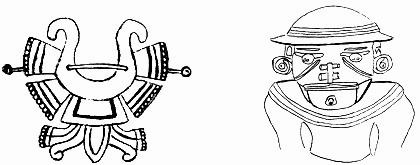
Figure 1
Mesoamerican Nose Ornaments
Left - Aztec gold nose ornament: Butterfly.
Note; the rod which went through the septum of the nose to support
the adornment.
Right - Tairona, gold Pendant : Warrior. Note; the segmented
nose ornament
of the nose and the oval chin adornment.
(Drawing after an image in "Lost Empires, Living Tribes" by the
National Geographic Society)
Next, if we look at the mouth area of the Humanoid side of the
"Face" we may see another example of a Mesoamerican ceremonial
feature (figure 2). Two objects, that appear to be teeth, can be
seen directly below the nose ornament in the mouth area. In the
center of each these front "teeth" is a dot, possibly representing a
dental gemstone. This "dot" feature is similar in design to the
Mesoamerican practice of decorating the front teeth with gemstones
and elaborate gold dental caps.
The Maya produced elaborate beads of
jade, obsidian, or iron pyrite that were fashioned into decorative
fillings which were imbedded into the front teeth. Take note of the
deliberate mutilation and decoration of the upper incisors in this
drawing of "Mesoamerican dentistry" from Uaxactun Mexico (figure 3).
The teeth on either side of the central incisors have been filed
down enabling the two front teeth to appear more prominent.
Amazingly, this is the same effect that is displayed on the Humanoid
side of the "Face".
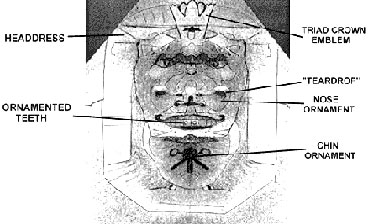
Figure 2
Analytical sketch of humanoid side of the MGS "Face"

Figure 3
Mesoamerican dentistry; Uaxactum, Mexico, Late Classic Maya.
Note; the "dot" shaped gemstone on the two front teeth.
(From; "The Gods and Symbols of Ancient Mexico and the Maya" an
illustrated dictionary of Mesoamerican religion, Mill & Taube, 1993,
p.77).
Back to Contents
The Feline
side of the "Face on Mars"
Since Hoagland first did the split of the "Face on Mars", the feline
side has always been considered to be a male African lion. With the
new image of the "Face" the feline characteristics are even more
apparent. The features of the feline "Face" when mirrored are
composed of a square shaped head with a crown, a mane, squinting
eyes, an ornamented nose, an almost circular muzzle, and a mouth
with fangs (figure 1). The Feline’s forehead is large and features a
squared off geometric crown that extends across the top of the head.
The crown also has a lot of faint decorative qualities in and around
it’s crest that are difficult to substantiate at this point. The
half portion of this "Crown" feature was also spotted by
Dr. Tom Van Flandern and referred to as the "Crest" in his in-depth analysis of
the unmirrored "Face". The "mane" feature is located in the
wave-like ridges that are found around the lower portion of the neck
forming a "beard-like" effect. From the times of the Olmec, and the
cultures that followed, many of their kings and gods had small
growths around the neck area that are classified as remnants of
"beards" by archaeologists.
Notice the small beard on this Maya
glyph of the Bearded Jaguar God (figure 2a.) and also on this
second glyph of a bearded jaguar (figure 2.b). Since facial hair is
not an attribute of either the indigenous Mesoamericans nor the
Negroid Africans or Asians, where did this idea originate? Many
researchers attribute these beards to be of a Semitic influence and
surmise an ancient link between the "Old" and "New Worlds". They
believe the beards on the glyphs and various faces of gods, were
meant to mimic the beards of these Semitic people.
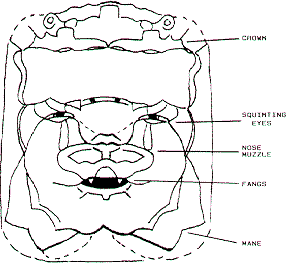
Figure 1
Analytical Drawing; The Feline side of the Face. Note; the bearded
Jaguar appearance.
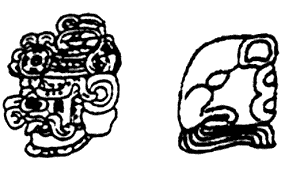
Figure 2
Left - Bearded Jaguar God; Maya glyph
Right - Bearded Jaguar Glyph; Maya glyph.
Note; the beard under the chin in both glyphs.
Like the Olmec and many other
Mesoamerican cultures, the Egyptians also wore false beards, as can
be seen in the death mask of Tutankhamun. It is thought that the
Egyptians used the false beards to mimic these same Semitic kings
(such as
the Sumerians).
Mesoamerica had it’s own lion in the form
of the jaguar. It would be reasonable to assume that the Olmec would
have regarded the jaguar as the New World’s equivalent of the lion.
Since the jaguar does not have a mane it would also be reasonable to
assume that the ancient Olmec would have regarded the lion, with
it’s full mane, as a "bearded jaguar".
In the National Museum of
Anthropology in Mexico City there is a large Aztec reliquary that is
carved in the shape of a full "jaguar" (figure 3). This amazing
sculpture which weighs over six tons was unearthed at Templo Mayor
in Mexico City way back in 1790. The most intriguing characteristics
of this so-called jaguar sculpture is that it has no spots, which a
jaguar does, and it has a mane, which a jaguar does no. Note; that
the partial mane on this reliquary is similar in size and shape to
the "mane" feature found on the Feline side of the "Face".
The
mythology of the Jaguar God is associated with the Maya god
archeologists call GIII, who is human in aspect and has jaguar
features including a "beard".
Figure 3
Aztec Reliquary (side view) from "Myths of the World; Gods of the
Inca, Aztec and Maya", by Timothy R. Roberts, p. 67.
Front view from "The Mighty Aztecs", Gene s. Stuart, Mark Godfrey
(c) The National Geographic Society, 1981
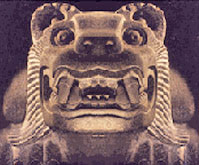
Aztec reliquary (front view)
A Bearded Jaguar
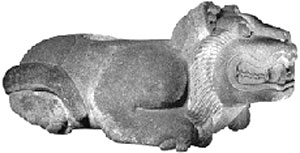
Aztec Reliquary (side view)
A Beaded Jaguar
Back to Contents
The "Face on
Mars" found at Cerros
On the face of an ancient Olmec/Maya two-tiered pyramid at Cerros
Mexico (50 B.C.), two fascinating sculptural masks are present. The
top two human faced masks represent the planet Venus as the morning
star on the east and the evening star on the west. The lower masks
are the Jaguar Sun God representing the rising sun on the east and
the setting sun on the west.
These two celestial masks have a
striking resemblance to a bifurcated mask on Mars known as "The
Face" (figure 3&4).

Figure 3
Comparison of the Humanoid side of the "Face on Mars" with Cerros
Temple "Venus Mask".
Left; Mirrored Humanoid side of Face on Mars.
Right; Morningstar (Venus) mask on temple panel at Cerros
Mexico.
Note; the facial ornaments and "W" shaped triad crown emblem on each
headdress.

Figure 4
Comparison of Mirrored Feline side of the "Face on Mars" with Jaguar
Sun god mask at Cerros.
Left; mirrored Feline side of the "Face on Mars".
Right; Jaguar Sun mask on temple panel at Cerros Mexico.
Note; drawings of both Cerros masks are from "A Forest of Kings", by
Linda Schele & David Freidel 1990, p.113.
We find it VERY interesting that Linda Schele was invited to speak
at NASA in 1995 at a seminar entitled; "The Universe: Now and
Beyond". Considering her knowledge of these "Face-like" masks at Cerros, what did
NASA discover, and how long have they known it?
Back to Contents
Two Faced
To anyone familiar with the pictorial characteristics of Mayan
hieroglyphs it soon becomes quite apparent that a significant amount
of their glyphs are based on the use of half and profiled faces. The
Maya developed a pictographic system that incorporates an almost
endless array of eloquently characterized faces that are fashioned
in the genre of a "severed" man’s head.
The isolated image of a
severed head was seen as a central symbol of royal power and
sacrifice among the kings of the Maya. This ritual of decapitation
not only played a major role in Mesoamerican religion it also
provided a rich lexicon of faces that were assembled into a complex
pictographic language (figure1). The first example, on the left, is
a frontal view of a Pumpkin head with a Human profile. The second,
on the right, is a frontal view of a Parrot with a Human profile.
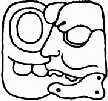 
Figure 1
Maya "split faced" glyphs.
Left: Pumpkin & Human
Right: Parrot & Human
(Additional examples
available in our book)
The Maya also produced a variety of
bifurcated sculptures and two-faced masks (figure 2).
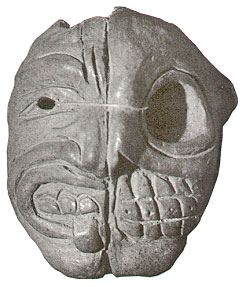 
Figure 2
Maya Two Faced Mask
Left: Human/Jaguar Skull (ceramic)
Right: Jaguar/Human (ceramic)
Back to Contents
The Book
THE BOOK: In what can only be described as the most important
archeological and sociological discovery in human history, "The
Cydonia Codex " offers persuasive evidence of aesthetic and symbolic
design on the surface of the planet Mars. The authors’ research
encompasses over ten years of study and analysis of NASA photographs
of the "Face on Mars" and its surrounding complex.
Beginning with
the famous 1976 photograph of a mile-long formation found on the
surface of Mars that strongly resembles a human face, Haas and
Saunders offer side-by-side comparisons of the art and sculpture of
pre-Columbian Mesoamerica with a set of corresponding geoglyphic
structures found in the Cydonia region of Mars.
The implication is
staggering — Earth’s history and humankind’s origins could be very
different than commonly believed.
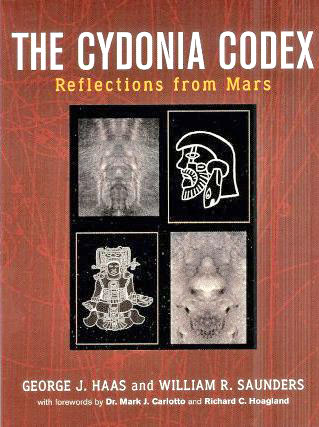
The new cover (above)
The book edition that is now available through North Atlantic Books
(Frog, Ltd.); features forewords by both Richard C. Hoagland & Dr.
Mark Carlotto. Includes black-and-white photos throughout, as well
as illustrations (330 pages).
About the authors
George J. Haas:
is founder and premier investigator of The Cydonia
Institute which was established in 1991. He is a member of the
Pre-Columbian Society of the University of Pennsylvania. Mr. Haas is
also an Artist, art instructor, writer, and curator. He is a member
and former director of the Sculptors Association of New Jersey. He
has also authored numerous monographs for various art exhibitions
and had a one person show at the OK Harris Gallery of Art in New
York City’s SoHo. He became interested in the "Face on Mars" after
reading a book on the subject by Randolfo Rafael Pozos in 1991. Mr.
Haas lives in New Jersey with his wife Dr. Joy Cole and has three
daughters.
William R. Saunders:
is a graduate of the University of Alberta in
Edmonton in 1977 with a bachelor of science degree in geomorphology.
He began work in the petroleum industry in Calgary, Alberta in 1978
and currently works as an independent petroleum geoscience
consultant in Calgary. Mr. Saunders began looking at the Mars Global
Surveyor images with their first release in April 1998. He met Mr.
Haas on a web site conference room shortly afterwards.
Reviews/Endorsements
Haas/Saunders’ research provides clear evidence that the Maya (among
others) created the same “symbolic duality” in their sculpture and
mythology as we have now discovered in a northern Martian region
called “Cydonia.”
- Richard C. Hoagland, author of The Monuments of Mars
.............................................
I applaud the authors’ cross-cultural approach to investigating
possible Martian archaeological sites. By suggesting that a prior
technological civilization might have been driven by an aesthetic
agenda, ’The Cydonia Codex’ offers a new arena for speculation --
which is precisely what’s needed to further the investigative
process.
- Mac Tonnies, authors of After the Martian Apocalypse:
Extraterrestrial Artifacts the Case for Mars Exploration
.............................................
The authors have obviously done a great deal of research not only
into the Martian structures but also into ancient Mesoamerican and
other cultures and have shown how the images from Mars are repeated
in the religious and cultural artifacts from those ancient
civilizations. The information is well laid out and overall an
excellent informative work.
- Shane Bowden, geologist Alberta Canada
...........................................
This book gives unique insight into the many questions surrounding
man’s origins and in my mind establishes stunning evidence for a
direct connection between us and a forgotten culture found on the
planet Mars.
- Jim Miller, founder of Anomaly Hunters
Back to Contents
Eccentric
Faces at Mensae Cydonia
by
George J. Haas
In the center of a recently released narrow angle image from
Cydonia
Mensae (R-14 02211), four totemic profiles of Maya-like faces have
been found within the ridge line of the exposed sloping terrain
(Figure 1).

Figure 1
Totemic Faces
(Cydonia Mensae R-14 02211)
When the four left facing profiled faces are highlighted (in green)
their features and ornamentations become quite discernable (Figure
2). Starting from the upper right side a serpent headed crest crowns
a small Olmecide head that acts as a headdress to the Jester-like
head below it.
Note the small serpent-like ornament hanging down in
front of the Jester’s face. Notice the Jester’s squinting eye, mouth
line and pointed nose.
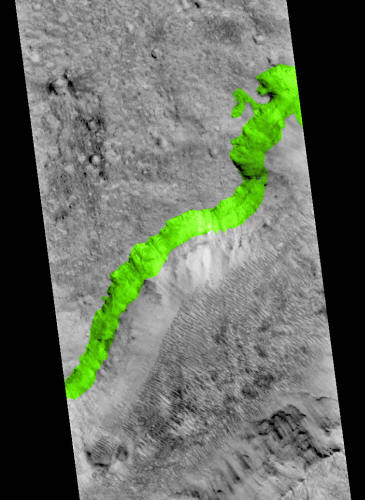
Figure 2
Totemic Faces (colorized)
(Cydonia Mensae R-14 02211)
Following the serpentine shape of the totem, the third face is
located at the center of the exposed ridge. Because this face
appears to be lightly incised, which may be the result of erosion,
its features are difficult to ascertain. With that said, the face
resembles the profile of the Indian Chief that is etched on the now
famous 1929 five dollar gold piece. Notice the stern face and
feathered headdress that follows the incline of the ridge.
Below the
Indian Chief is the fourth and largest of the profiled
faces that is highlighted in lime green. Notice the eye, prominent
nose, protruding tongue, and the dark thick lips that provide a
snarling aspect to the mouth.
The overall totemic design of this composite of profiled faces
carved along this Martian ridgeline is reminiscent of the many
eccentric flints discovered throughout Mexico (Figure 3).
 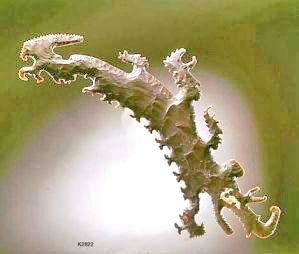
Figure 3
Maya Eccentric Flints
Left: Staff with three profiled heads
Dumbarton Oaks, Washington, D.C.
Right: Celestial Monster with affixed heads
Dallas Museum of Art
Many of these flints were extremely complex and of delicate design,
featuring jagged profiles that were chipped along the edge of
precious stones such as jade and obsidian. When the profiled head at
the top of the eccentric flint in Figure 3a is compared to the
crowned Jester head found at the top of the Martian formation, a
common iconography is profoundly obvious (Figure 4).
Notice the
profiled heads with arching crest and protruding ornaments attached
to both headdresses.
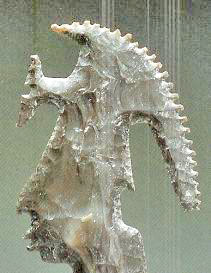 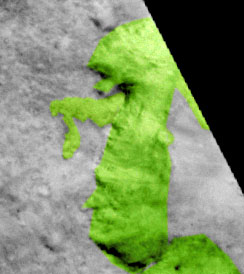
Figure 4
Eccentric Flint Comparison
Left: Maya Head (Detail of Figure 3a)
Right: Martian Jester Head (Detail of Figure 2
above)
Note the headdress extends past the available data.
A similar set of profiled faces was discovered near the
Barnard
Crater, in the Hellas region, by JP Levasseur in MOC strip M0200180.
His analysis can be found here: (Right-Facing Profiles).
Back to Contents
The Cydonia
"Viking" - A Beared Quetzalcoatl
by George J. Haas and William Saunders
Located with in the Cydonia Complex is a structure that has become
known as the “City Center Pyramid” or the “Main Pyramid” (FIGURE 1).
Although the entire structure was not captured by the 1998 MGS
camera, we approximate its length and width to each be about 3
kilometers (2 miles).
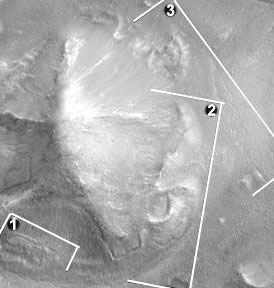
Figure 1
Context image: Main Pyramid of the Cydonia Complex (1998)
Inverted and contrast adjusted with notations (SP1-25803).
Note pictograph marked number 1.
As a result of the many early interpretations of Viking data, the
“Main Pyramid” was once thought to be an enormous four-sided pyramid
based on an Egyptian model. However, the 1998 MOC image (SP1-25803)
shows that this is not the case. It now appears to be five-sided,
segmented by five major “spines” radiating from the top to an almost
circular base. The most prominent anomalies on this structure are an
almond shaped “crater” accompanied by two adjoining rectangular
impressions on the northern end of the “pyramid.”1
The new image reveals that “Main Pyramid” has a complex series of
radiating “spines” and a set of geometrically shaped features within
its surrounding apron. After a considerable amount of time was
invested in evaluating these formations, we noted that they were
parts of a complex set of half-images along the segmented base line
(FIGURE 1). Although we uncovered three pictographic portraits that
appear as either the right or left side of a whole image we will
only focus on the pictograph marked number 1 in this study.2
The pictograph from the “Main Pyramid” marked number 1 in Figure 1
consists of a half faced portrait (FIGURE 2). When the pictograph is
cropped and rotated to a vertical presentation, the heads
demarcation line can be detected running along the adjoining
terrain. When mirrored the head appears to be composed of a
full-bearded face with twisting braids, deep set eyes, a nose, and
mouth. The head is completed with a Viking-like helmet.
The “Viking”
head is roughly 700–800 meters (half a mile) in length from the top
of the helmet to the neck.

Figure 2
The Viking Pictograph
Detail: Main Pyramid (marked number1 in figure 1)
LEFT, Half Faced Pictograph
CENTER, Demarcation Line
RIGHT, Mirrored Pictograph (Viking)
When the “Viking” head is compared to a typical Viking age helmet
the common features become quite apparent (Figure 3). Notice the
central helmet crest, the brow and nose guard, the false mustache
and lower-helmet extensions.

Figure 3
Saxon and Martian Helmet Comparison
Detail of Main Pyramid (marked number1 in figure 1)
with inset of a Saxon Helmet on left side.
(Image source, History Unearthed, Leonard Woolley,
(Ernest Benn Limited: London), 1963, fig. 173, p.167.)
Although our initial judgment of this structure led us to believe
that it represented a Viking-like portrait, we acknowledge that this
image also bears many similar features to the Aztec depiction of
Quetzalcoatl (the “Feathered Serpent”) as seen in Figure 4.
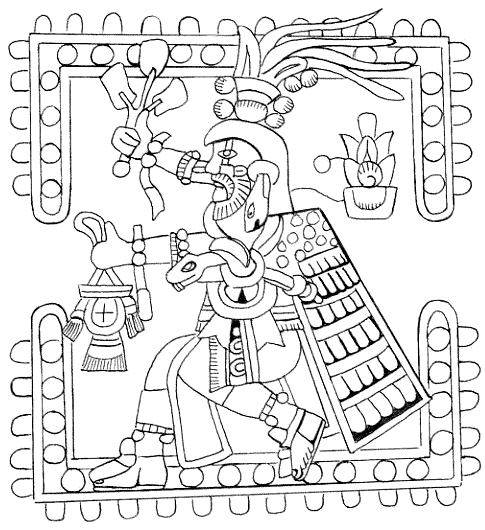
Figure 4
Winged Quetzalcoatl (Aztec Codex)
Drawing by George J. Haas
(Image source: Mysteries of the Mexican Pyramids, by Tompkins, page
385.)
This image of Quetzalcoatl is bearded and wears a helmet strikingly
similar to the Mars figure. The portrait includes a lower-helmet
extension and long braids made of serpents. If one looks closely at
the braids of the Martian image in Figure 5 it also appears as
though they are formed by a coiled serpent.
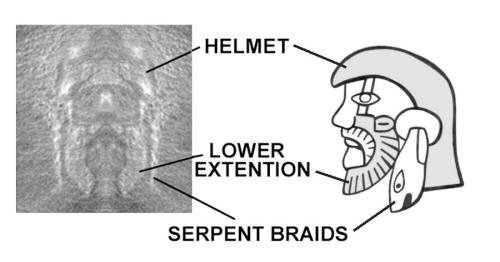
Figure 5
Comparison of the Viking and Quetzalcoatl
LEFT, detail of Martian Viking
RIGHT, Detail of Aztec Quetzalcoatal
Note the lower extention of Quetzalcoatl’s helmet
and the serpent braids match the mars image.
Because the Viking pictograph shares such strong iconographic
similarities with Mesoamerican motifs, we assert that the pictograph
identified as number 1 in Figure 1 is a Martian representation of
the Maya god Quetzalcoatl in his personification of the morning
star, Venus.
Similar half-faced geoglyphs have been recorded in Peru. Far to the
north, beyond the city of Lima, are the
ruins of Caral, located in
the Supe Valley. From recent excavations of this site, some
archaeologists are hailing this almost forgotten complex as the home
of the earliest known settlement in the New World. Results of new
radiocarbon tests have dated a range of site mounds and structures
to well before 2600 B.C.3
Just beyond this ancient complex of mounds and half-buried pyramids
is an immense half-faced stone geoglyph set into the surface of this
once sacred ground (Figure 6).
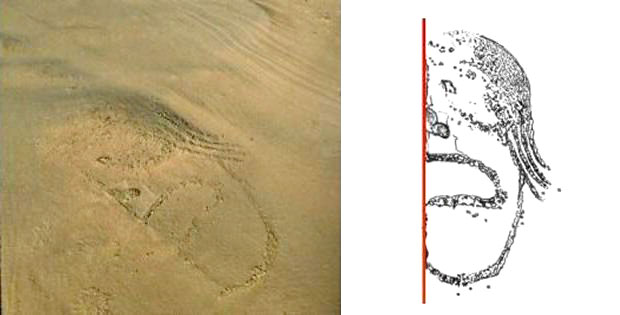
Figure 6
Caral Half Faced Geoglyph (Caral, Peru, 2500 B.C.)
LEFT, Aerial View of Half-Faced Geoglyph
RIGHT, Drawing with demarcation line
(Image source: Smithsonian, August 2002, Vol. 33, no.5, page 64.)
Drawing by George J. Haas
Notice the “D”-shaped head with its large gaping mouth and raked
hair. It should be noted that this partial face is not carved in
profile - it is designed in a “cut in half” manner. In the
illustration on the right side of Figure 6, notice the demarcation
line runs right down through the forehead - cutting the nose and
chin in half. Like the half-faced Viking pictograph found at
Cydonia,
the Caral face was also constructed to be seen from high above the
ground.
Back to Contents
Footnotes
These anomalous features were not only noticed by us and many other
researchers, but became the main focus of an investigation set forth
by Stanley V. McDaniel of the Society for Planetary SETI Research (SPSR).
See Stanley V. McDaniel, “Peculiarities At ‘Main Pyramid.’” The
McDaniel Report Newsletter, May, 7, 1998:
http //www.mcdanielreport.com.
The full analysis of the Main Pyramid, including pictographs number
2 and 3, is available in the book by George J. Haas and William R.
Saunders “The Cydonia Codex Reflections from Mars, (North Atlantic
Books, Frog, Ltd.,2005), pp.121-139.
Ruth Shady Solis, Jonathan Haas, and Winifred Creamer, “Dating Caral,
a Pre-ceramic Site in the Supe Valley on the Central Coast of Peru,”
Science 292, no. 5517 (April 27, 2001), pp. 723–726.
Back to Contents
|











































